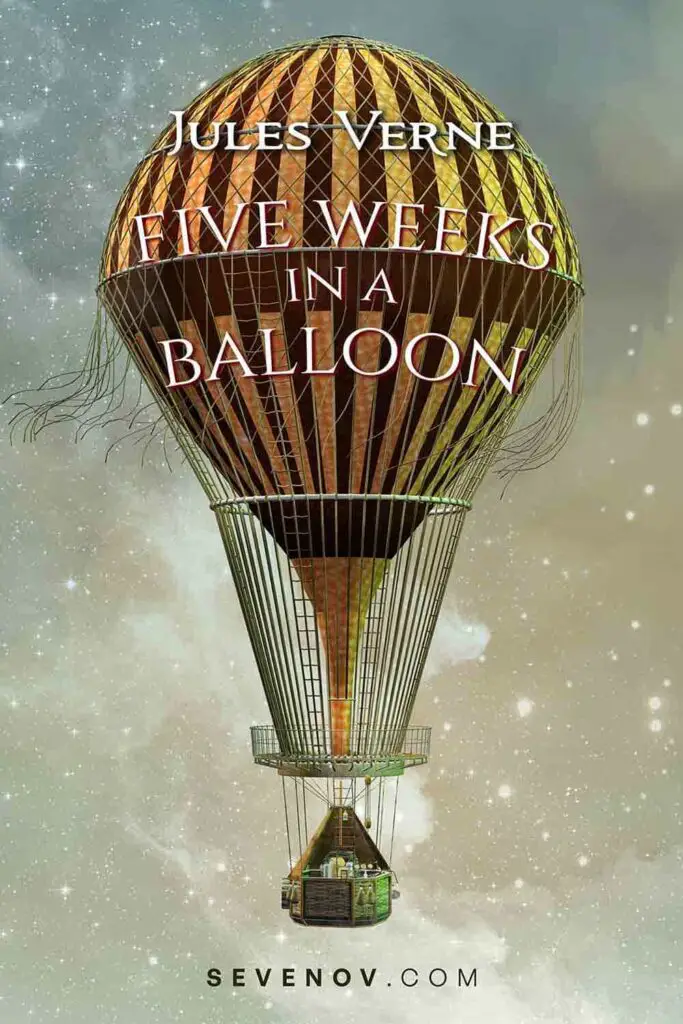
Five Weeks in a Balloon by Jules Verne
Author: Jules Verne
Published: 1863
Genre: Adventure, science fiction
Read Five Weeks in a Balloon online at PageVio
Five Weeks in a Balloon by Jules Verne takes readers on a captivating journey of adventure and exploration, characteristic of Verne’s inventive storytelling. Set against the backdrop of Africa’s vast and uncharted territories, this novel showcases three explorers’ thrilling exploits as they navigate the continent in a hot air balloon.
Published in 1863, the book’s engaging plot and historical context offer entertainment and insight into the 19th-century spirit of discovery.
Verne’s carefully crafted characters and detailed settings immerse readers in a world where technology and human ambition intersect. The journey undertaken by the protagonists highlights the challenges and wonders of early exploration, making Five Weeks in a Balloon a timeless piece that continues to inspire wonder and curiosity.
1. Five Weeks in a Balloon Summary
Dr. Samuel Fergusson, a scholar and explorer, sets out to travel across the still largely unexplored African continent with his manservant Joe and his friend, professional hunter Richard “Dick” Kennedy. Utilizing a hydrogen-filled balloon equipped with a unique mechanism that negates the need to release gas or discard ballast to control altitude, Dr. Fergusson embarks on a journey aimed at connecting the expeditions of Sir Richard Burton and John Hanning Speke in East Africa with those of Heinrich Barth in the Sahara and Chad regions.
The trip begins in Zanzibar on the east coast, passing over Lake Victoria, Lake Chad, Agadez, Timbuktu, Djenné, and Ségou, and finally reaching St. Louis in present-day Senegal on the west coast. The book erroneously describes the interior of Africa near the modern-day Central African Republic as a desert, when it is a savanna.
A significant portion of the initial exploration focuses on finding the source of the Nile. The second leg of the journey aims to link up with other explorers. The narrative is filled with scenes of adventure, including conflicts with natives and environmental challenges.
Throughout these adventures, the protagonists overcome challenges through perseverance. The novel is filled with coincidental moments where trouble is averted by timely winds or serendipitous observations, with frequent references to a higher power watching over them.
The balloon eventually gives out before the end of the journey but manages to carry the protagonists far enough to reach friendly lands and, ultimately, back to England, thus succeeding in the expedition. The story concludes abruptly after the African trip, with only a brief synopsis of what follows.
2. Characters
- Dr. Samuel Ferguson: An experienced explorer with a scientific mind. He leads the expedition with confidence and innovation.
- Joe: Ferguson’s loyal servant, practical and resourceful, offering vital support during the journey.
- Dick Kennedy: A hunter skeptical of the balloon adventure but joins due to his friendship with Ferguson. His bravery and skills prove essential.
3. Background and Context
Five Weeks in a Balloon provides a vivid narrative of exploration and innovation in travel through the use of a hot air balloon.
Literature and Exploration
Verne’s novel is set against the backdrop of 19th-century African exploration. During this period, Africa was known as the “Dark Continent” due to its uncharted territories.
Verne integrated real-life journeys and discoveries in Africa into his fictional narrative. His work often included detailed, scientific facts drawn from journals and exploration records, making it informative as well as entertaining.
Innovation in Travel
The use of a balloon to explore uncharted territories was revolutionary. Verne’s depiction of the aerial voyage emphasizes the advantages of a balloon over other forms of travel.
The journey undertaken by Dr. Samuel Ferguson, Dick Kennedy, and Joe highlights the pioneering spirit of the era. Verne imagined the use of atmospheric currents to navigate, showcasing his innovative thinking.
Setting and World
The journey begins in London, England, moving to Zanzibar in Africa. The aerial voyage covers diverse African landscapes, including deserts, rivers like the Senegal and Nile, and significant landmarks like Mount Duthumi.
These elements highlight the contrast between the developed world of England and the uncharted territories of Africa, enriching the narrative with vivid imagery. The balloon, Victoria, is central to this exploration, symbolizing innovation and adventure.
| Jules Verne Bibliography | |
| Novels | Five Weeks in a Balloon | Journey to the Center of the Earth | From the Earth to the Moon | The Adventures of Captain Hatteras | In Search of the Castaways | Twenty Thousand Leagues Under the Seas | Around the Moon | A Floating City | The Adventures of Three Englishmen and Three Russians in South Africa | The Fur Country | Around the World in Eighty Days | The Mysterious Island | The Survivors of the Chancellor | Michael Strogoff | Off on a Comet | The Child of the Cavern | Dick Sand, A Captain at Fifteen | The Begum’s Fortune | Tribulations of a Chinaman in China | The Steam House | Eight Hundred Leagues on the Amazon | Godfrey Morgan | The Green Ray | Kéraban the Inflexible | The Vanished Diamond | The Archipelago on Fire | Mathias Sandorf | The Lottery Ticket | Robur the Conqueror | North Against South | The Flight to France | Two Years’ Vacation | Family Without a Name | The Purchase of the North Pole | César Cascabel | Mistress Branican | The Carpathian Castle | Claudius Bombarnac | Foundling Mick | Captain Antifer | Propeller Island | Facing the Flag | Clovis Dardentor | An Antarctic Mystery | The Mighty Orinoco | The Will of an Eccentric | The Castaways of the Flag | The Village in the Treetops | The Sea Serpent | The Kip Brothers | Travel Scholarships | A Drama in Livonia | Master of the World | Invasion of the Sea |




